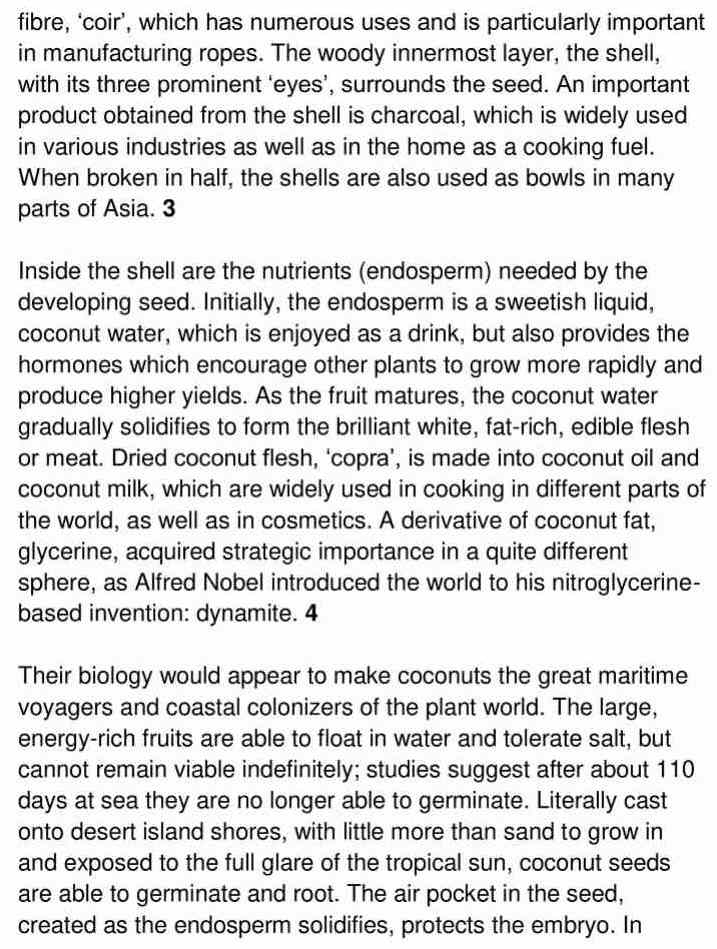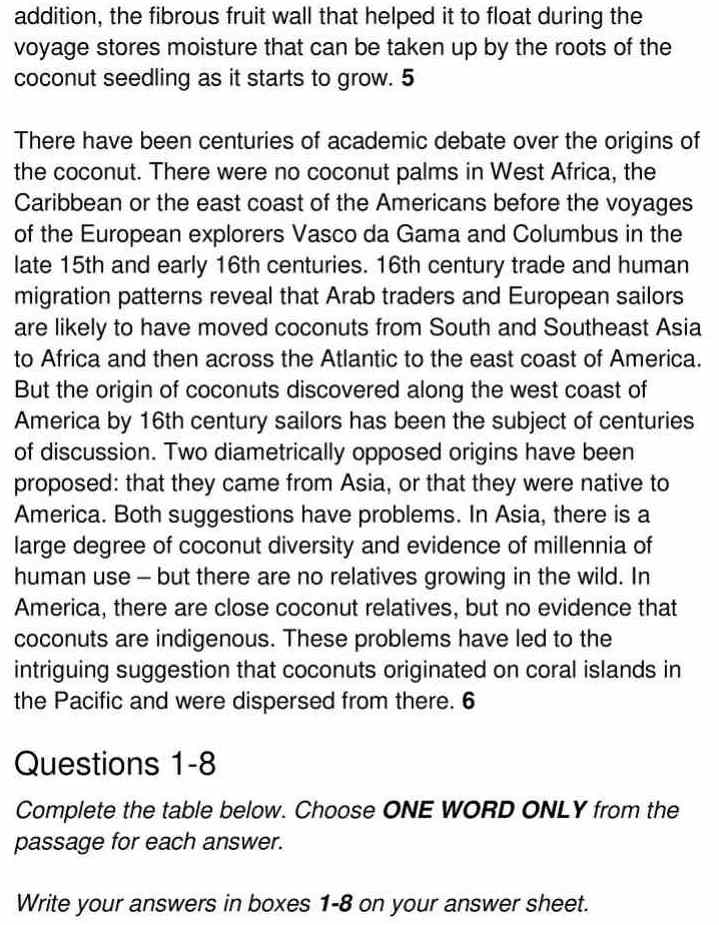The Coconut Palm – IELTS Reading Answers
6 min read
Updated On
-
Copy link
Table of Contents

Limited-Time Offer : Access a FREE 10-Day IELTS Study Plan!
The Academic passage ‘The Coconut Palm’ is a reading passage that appeared in an IELTS Test.
It contains some of the IELTS reading question types. If you are interested in familiarising yourself with all the question types, don’t hesitate to take an IELTS reading practice test.
The Coconut Palm





Answers
Unlock Answers
The answers to questions 1-13 are given below along with their explanations.
| Question Number | Answer | Explanation |
| 1 | furniture | In paragraph 2, the writer says that: “The coconut palm has a smooth, slender, grey trunk, up to 30 metres tall. This is an important source of timber for building houses, and is increasingly being used as a replacement for endangered hardwoods in the furniture construction industry”. Here ‘making’ means construction. Thus, the trunk is used to build houses and also to make furniture. Hence the answer is furniture. |
| 2 | sugar | In paragraph 2, the author mentions that, “Immature coconut flowers are tightly clustered together among the leaves at the top of the trunk. The flower stems may be tapped for their sap to produce a drink, and the sap can also be reduced by boiling to produce a type of sugar used for cooking”. Here, the sap from the flower stems can be used as a drink or boiled to make a kind of sugar. Hence the answer is sugar. |
| 3 | ropes | In paragraph 3, the writer explains, “The thick fibrous middle layer produces coconut fibre, coir, which has numerous uses and is particularly important in manufacturing ropes”. This paragraph talks about the fruit of coconut trees. Here, the thick fibre from the middle layer, coir, is used to make ropes. Hence the answer is ropes. |
| 4 | charcoal | At the end of paragraph 3, the writer describes, “The woody innermost layer, the shell, with its three prominent ‘eyes’, surrounds the seed. An important product obtained from the shell is charcoal, which is widely used in various industries as well as in the home as a cooking fuel” Here, the uses of the ‘woody inner layer’ of coconut shells are explained. The inner layer of the shell, therefore, provides charcoal for industries and also for cooking. Hence, the answer is charcoal. |
| 5 | bowls | In paragraph 3, the writer mentions the other use of the inner layer, “When broken in half, the shells are also used as bowls in many parts of Asia“. Halved shells are used as bowls, where, halved refers to being broken in half. Hence, the answer is bowls. |
| 6 | hormones | In paragraph 4, the author explains the uses of coconut water: “…coconut water, which is enjoyed as a drink but also provides the hormones which encourage other plants to grow more rapidly and produced higher yields”. Coconut water provides hormones for other plants; therefore, it is a source of hormones for those plants. Hence, the answer is hormones. |
| 7 | cosmetics | In paragraph 4, the writer says “Dried coconut flesh, copra, is made into coconut oil and coconut milk, which are widely used in cooking in different parts of the world, as well as in cosmetics”. Here, coconut oil and milk are used for cooking and for making cosmetics. Hence the answer is cosmetics. |
| 8 | dynamite | In paragraph 4, the author states, “A derivative of coconut fat, glycerine, acquired strategic importance in a quite different sphere, as Alfred Nobel introduced the world to his nitroglycerine-based invention: dynamite“. ‘Nitroglycerin-based’ means that glycerine was one of the basic ingredients. Nobel’s invention was dynamite. Hence, the answer is dynamite. |
| 9 | FALSE | In paragraph 5, the author says, “Literally cast onto desert island shores, with little more than sand to grow in and exposed to the full glare of the tropical sun, coconut seeds are able to germinate and root”. ‘Glare’ means to shine with a very bright and unpleasant light, which is the opposite of shade. We often wear sunglasses to protect against the glare of the sun. So, coconut seeds do not need shade in order to germinate, they can germinate in the sun. Hence, the statement is FALSE. |
| 10 | FALSE | In the last paragraph, the writer says. “16th-century trade and human migration patterns reveal that Arab traders and European sailors are likely to have moved coconuts from South and Southeast Asia to Africa and then across the Atlantic to the east coast of America“. This sentence tells us about the origins of coconuts that were probably moved from Asia to America – via Africa. This route is the opposite of the statement. Here, the word ‘probably’ refers to likely and ‘transported’ means moved. Hence, the statement is FALSE. |
| 11 | NOT GIVEN | In paragraph 6, the author mentions that there were no coconut palms in West Africa, the Caribbean or the ‘east coast of the Americas’ before the voyages of the European explorers Vasco da Gama and Columbus in the late 15th and early 16th centuries. Later, the patterns of the 16th century trade and human migration reveal that Arab traders and European sailors are likely to have moved coconuts from South and Southeast Asia to Africa and then across the Atlantic to the east coast of America.But the origin of coconuts discovered along the ‘west coast of America by 16th century sailors has been the subject of centuries of discussion. As there is no reference of any comparison between the coconuts on the west and the east coast of America, the answer is ‘NOT GIVEN. |
| 12 | TRUE | In the last paragraph, it is given that “In Asia there is a large degree of coconut diversity and evidence of millennia of human use – but there are no relatives growing in the wild”. So, we may conclude that as there are no wild coconuts growing in Asia, all the varieties must be grown or cultivated by the Asians. Hence the statement is TRUE. |
| 13 | NOT GIVEN | The only reference to Pacific in the whole passage can be found in the sixth paragraph which says that the problems of not having a large degree of coconut diversity and evidence of millennia of human use have led to the intriguing suggestion that coconuts originated on coral islands in the Pacific and were dispersed from there. But, the author did not discuss the different ways of coconut cultivation in America in this passage. Hence, the answer is NOT GIVEN. |
Check More IELTS Reading Answers
| Nature Or Nurture Answers | The Falkirk Wheel Answers |
| The Department Of Ethnography Reading Answers | The Lost City Reading Answers |
| Gifted Children Learning Answers | Making Every Drop Count Answers |
Also check :
Practice IELTS Reading based on question types

Start Preparing for IELTS: Get Your 10-Day Study Plan Today!
Recent Articles

Nehasri Ravishenbagam

Haniya Yashfeen

Haniya Yashfeen

Haniya Yashfeen




Post your Comments